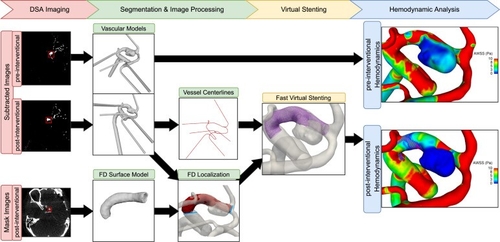NEWS
Neue interdisziplinäre Studie zur Behandlung von intrakraniellen Aneurysmen
Mitarbeitende der STIMULATE-Forschungsgruppen Neuro Clinic, Image Processing und Medical Flows haben in einem interdisziplinären Projekt gemeinsam mit dem Implantathersteller Acandis GmbH neue Erkenntnisse über die Behandlung von intrakraniellen Aneurysmen gewinnen können.
Für die Untersuchungen wurden patientenspezifische 3D-Modelle von Patient:innen generiert, welche in der Universitätsklinik Magdeburg mit einem neuartigen Derivo2 Flow Diverter Stent behandelt wurden. Mithilfe eines intern entwickelten virtuellen Stenting-Tools konnte der behandelte Zustand realistisch anhand der klinischen Daten nachgebildet werden.
Die Studie zeigt durch intensive hämodynamische Vergleiche mittels zeitabhängiger numerischer Strömungssimulationen gewünschte Flussreduktionen in den behandelten Aneurysmen auf. Allerdings konnten eine variable Effektivität im Verlauf des Herzzyklus sowie Abhängigkeiten der Behandlungsergebnisse von anspruchsvollen Gefäßmorphologien festgestellt werden.
Die Studie wurde in der renommierten Fachzeitschrift Computers in Biology and Medicine (Impact Faktor 6,7) publiziert:
Stahl, J., Marsh, L. M. M., Thormann, M., Ding, A., Saalfeld, S., Behme, D. & Berg, P. (2023). Assessment of the flow-diverter efficacy for intracranial aneurysm treatment considering pre- and post-interventional hemodynamics. In Computers in Biology and Medicine (Vol. 156, p. 106720).
Elsevier BV. https://doi.org/10.1016/j.compbiomed.2023.106720

Abbildung 1: Multimodaler Arbeitsablauf auf Grundlage prä- und post-interventioneller Bildgebung, die zu Gefäß- und Stent-Oberflächenmodellen führt. Die Extraktion der Mittellinie und der Stent-Position basierend auf patientenspezifischen Bilddaten ermöglicht eine realistische virtuelle Stent-Platzierung und anschließende numerische Blutflussbetrachtung.
Figure 1: Multimodal workflow based on pre- and post-interventional imaging leading to vessel and stent surface models. Centerline and stent position extraction based on patient-specific imaging data enables realistic virtual stent placement and subsequent numerical blood flow assessment.
New interdisciplinary study on the treatment of intracranial aneurysms
Collaborators of the STIMULATE research groups Neuro Clinic, Image Processing and Medical Flows have gained new findings within an interdisciplinary project together with the implant manufacturer Acandis GmbH regarding the treatment of intracranial aneurysms.
For the investigations, patient-specific 3D models of patients were generated, who were treated with a novel Derivo2 Flow Diverter Stent at the University Hospital Magdeburg. Using an internally developed virtual stenting tool, the treated condition could be realistically recreated based on clinical data.
The study demonstrated desired flow reductions in the treated aneurysms by means of intensive hemodynamic comparisons using time-dependent numerical flow simulations. Moreover, variable efficacy over the cardiac cycle as well as dependencies of treatment outcomes on challenging vessel morphologies were observed.
The study was published in the renowned journal Computers in Biology and Medicine (impact factor 6,7):
Stahl, J., Marsh, L. M. M., Thormann, M., Ding, A., Saalfeld, S., Behme, D., & Berg, P. (2023). Assessment of the flow-diverter efficacy for intracranial aneurysm treatment considering pre- and post-interventional hemodynamics. In Computers in Biology and Medicine (Vol. 156, p. 106720).
Elsevier BV. https://doi.org/10.1016/j.compbiomed.2023.106720